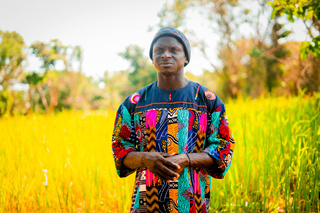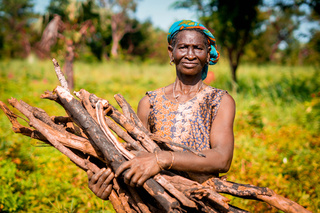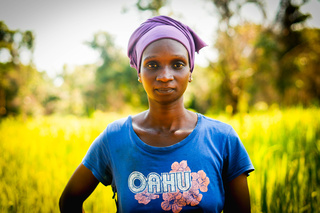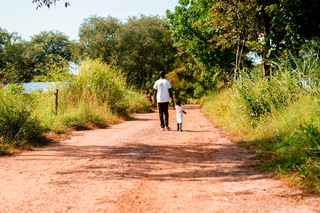share

Djenaba, who arrived in the village in 2021, cultivates her field of upland rice. | © A. Faye / HI
After being displaced for 30 years, the inhabitants of Bissine, Senegal, are returning to their land and starting to cultivate their fields again, a source of economic prosperity for an entire region.
9 October 1992 is a date that will remain etched in the memories of all the inhabitants of Bissine: on that day, the village was the scene of terrible violence. The village was bombed, houses were burnt down, villagers were killed - and people were forced to leave in haste, leaving behind their lives and their roots. It was 30 years before the first families dared to go home. Thanks to HI's demining operations, they know they can now return to the land of their ancestors in complete safety.
 In the early 1990s, around 2,500 people lived in Bissine. But the conflict between the Senegalese army and the fighters of the Movement of Democratic Forces of Casamance forced them to flee. When the events of 9 October unfolded, the villagers had only a few hours to leave their homes. In the rush and panic, families, relatives and friends were separated. The displaced fled to Senegal's major cities or settled in Gambia and Guinea-Bissau.
In the early 1990s, around 2,500 people lived in Bissine. But the conflict between the Senegalese army and the fighters of the Movement of Democratic Forces of Casamance forced them to flee. When the events of 9 October unfolded, the villagers had only a few hours to leave their homes. In the rush and panic, families, relatives and friends were separated. The displaced fled to Senegal's major cities or settled in Gambia and Guinea-Bissau.
"I was in the bush at the time of the attack. My family had stayed in the village. We fled in different directions and it wasn't until fifteen years later, in 2007, that I saw my sister again", explains Ismaïla Manga, the head of the village of Bissine.
For many, life in the big cities or abroad meant a loss of social position. Some of the inhabitants tell of harsh living and working conditions, working for people who exploited their distress. When the exodus took place, families had to leave behind their possessions, but above all their land, their greatest asset.
Yet in the heart of every Bissinois, hope burned brightly: committees were set up and meetings organised to keep a scattered community together. Parents brought their children up to remember their land and want to return to it one day.
"Each generation has tried to return. In the 2000s, some determined women organised themselves to try to return to the village. But they ran up against armed gangs, there were casualties and they had to give up. But God made it possible for us to be here today, to get our land back," says Ismaïla.
 Starting in 2020, the displaced began to return in small groups. But the village wasn’t safe: years of fighting in the region had left their mark, with explosive devices scattered everywhere. At the urging of local residents, HI was called in to conduct mine clearance operations in Bissine between July and October 2022. During this period, HI’s demining teams released almost 95,000 m² of land and destroyed 15 explosive devices.
Starting in 2020, the displaced began to return in small groups. But the village wasn’t safe: years of fighting in the region had left their mark, with explosive devices scattered everywhere. At the urging of local residents, HI was called in to conduct mine clearance operations in Bissine between July and October 2022. During this period, HI’s demining teams released almost 95,000 m² of land and destroyed 15 explosive devices.
The land in Bissine has always been fertile. Before the great exodus, it was one of the most productive villages in Casamance - a region nicknamed "the granary of Senegal" because of its exceptional climatic conditions. Harvests were abundant and families prospered. This dynamic benefited the whole region, as Bissine, located between Guinea Bissau and the Sedhiou region in eastern Senegal, is situated at the crossroads of regional trade. When the people of Bissine were forced to abandon their land and crops, the entire economic balance of the region was undermined.
 Now, with the return of the first families, the revival has begun. This fertile land, left fallow for 40 years, is now richer than ever, and the fields are ready to be cultivated again by the people returning. This is the case of Djenaba, aged 30, who arrived in the village in 2021, following her husband, originally from Bissine. Her mother-in-law still lives in Guinea, where she moved after the events of 9 October 1992. Djenaba grows upland rice in her fields:
Now, with the return of the first families, the revival has begun. This fertile land, left fallow for 40 years, is now richer than ever, and the fields are ready to be cultivated again by the people returning. This is the case of Djenaba, aged 30, who arrived in the village in 2021, following her husband, originally from Bissine. Her mother-in-law still lives in Guinea, where she moved after the events of 9 October 1992. Djenaba grows upland rice in her fields:
"It's hard work, because we don't grow in rice paddies, but in ordinary fields. Every day, I have to pull out the creepers that grow back all the time. I'd like to vary the crops and buy a machine to increase production and sell some of it. The land here is very rich," she explains.
It will take time and hard work for the village to regain its former prosperity. Many fields and rice paddies remain abandoned, waiting for families to return.
"Here, we grow according to the needs of the household. Here, women and men are partners and do the same tasks. In Bissine, for example, the women also cultivate the land," says Ismaïla.
Today, the village has around 375 inhabitants. For almost two years, all the families lived together in a large hut until, little by little, each household rebuilt or renovated the family home. Today, the challenge for Bissine is to bring back the other families, especially the young people who were born and grew up far away from the village.
"Many were born a long way from Bissine: they never knew the village as it used to be. They grew up in the city and never learned to farm. Returning means abandoning the life they have made in the host towns, and sometimes all the advantages that a big city can offer. To enable families to return, we need to improve the reception conditions in the village by building basic infrastructure. All the conditions have to be met so that the families can live in harmony and be self-sufficient in food for life," explains Ismaïla.
 Bissine's school reopened in 2020 - the first stone laid in the reconstruction of the village. Initially, it had 29 pupils. Over time, and with the return of families, the number of pupils has grown to around 130. Projects abound in this strong community, which has remained united in the face of adversity. The people aspire to just one thing: to rebuild their home.
Bissine's school reopened in 2020 - the first stone laid in the reconstruction of the village. Initially, it had 29 pupils. Over time, and with the return of families, the number of pupils has grown to around 130. Projects abound in this strong community, which has remained united in the face of adversity. The people aspire to just one thing: to rebuild their home.
"We want to open a meeting place for women and another for young people. We also want to build a multi-purpose centre where young people can study and get training, in masonry or electronics, for example. Being displaced enabled us to gain more experience through contact with other populations. It's this knowledge that we're going to put to good use in our community," concludes Ismaïla.
Senegal estimates the extent of contamination linked to the conflict in Casamance at 1,200,000 m² of land, spread over five departments. In May 2022, HI relaunched its demining operations in Casamance, where the organisation had already cleared more than 900,000 m² of land since 1996. HI's current two projects will clear 800,000 m² of land by 2025, helping to restore security and socio-economic prosperity to communities in the Ziguinchor and Sédhiou regions. These projects are funded by the European Union and the Dutch Ministry of Foreign Affairs.








HI is an independent and impartial aid organisation working in situations of poverty and exclusion, conflict and disaster. We work alongside people with disabilities and vulnerable populations, taking action and bearing witness in order to respond to their essential needs, improve their living conditions and promote respect for their dignity and fundamental rights.
HI is an independent and impartial aid organisation working in situations of poverty and exclusion, conflict and disaster. We work alongside people with disabilities and vulnerable populations, taking action and bearing witness in order to respond to their essential needs, improve their living conditions and promote respect for their dignity and fundamental rights.